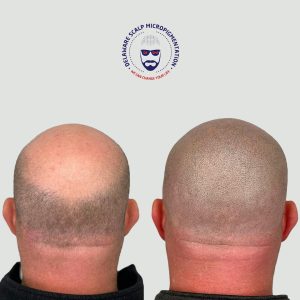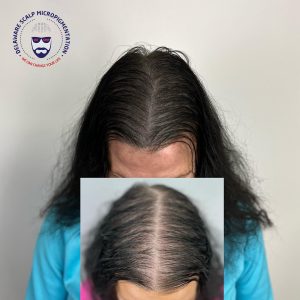Introduction
Scalp Micropigmentation (SMP) is a groundbreaking technique that has revolutionized the field of hair loss solutions. This innovative procedure offers a non-invasive and effective way to address the concerns of individuals experiencing various degrees of hair thinning, receding hairlines, and baldness. SMP involves the application of pigments to the scalp, creating the illusion of a full head of hair or adding density to thinning areas. In this article, we will explore the intricacies of SMP, its benefits, the procedure itself, the aftercare required to maintain optimal results, the psychological impact it has on individuals, the advancements in SMP technology, and the growing popularity of SMP as a hair loss solution.
Understanding Scalp Micropigmentation
Scalp Micropigmentation is a specialized form of cosmetic tattooing that simulates the appearance of hair follicles on the scalp. The procedure involves the precise application of microdots of pigment into the epidermal layer of the scalp. By replicating the look of natural hair follicles, SMP provides the illusion of a closely-cropped hairstyle, effectively concealing hair loss and creating a fuller appearance.

Unlike traditional tattooing, which uses ink and penetrates the deeper layers of the skin, SMP utilizes specifically formulated pigments that are designed to mimic the color of natural hair. These pigments are applied with micro-needles to achieve a natural and realistic look. The size, shape, and density of the microdots are meticulously tailored to match the client’s hair color and style, ensuring seamless integration with existing hair or creating the desired hairline for those who are completely bald.
The Benefits of Scalp Micropigmentation
Restoring Confidence: Hair loss can have a significant impact on an individual’s self-esteem and overall confidence. SMP offers a safe and effective solution to address these concerns, providing individuals with a renewed sense of self-assurance. By recreating the appearance of a full head of hair, SMP helps to restore confidence and improve the quality of life for those struggling with hair loss.
Non-Surgical and Low Maintenance: Unlike hair transplant surgeries, which can be invasive and require a lengthy recovery period, SMP is a non-surgical procedure that typically requires no downtime. The process is minimally invasive and performed on an outpatient basis. Additionally, SMP requires minimal maintenance compared to other hair loss treatments. With proper care and occasional touch-ups, SMP results can last for several years.
Versatile and Customizable: SMP is a versatile technique that can be tailored to meet the unique needs and preferences of each individual. Whether someone desires a natural-looking hairline, wants to add density to thinning hair, or aims to completely replicate a closely-shaved head, SMP can be customized to achieve the desired outcome. The technique can also be utilized for both men and women, making it an inclusive option for individuals with diverse hair loss patterns.
Psychological Impact: Beyond the physical benefits, SMP has a profound psychological impact on individuals who undergo the treatment. Many people experience a significant boost in self-confidence and self-esteem, which can positively affect various aspects of their lives. The restored appearance of a full head of hair can enhance social interactions, professional opportunities, and overall well-being.
The SMP Procedure and Aftercare
Initial Consultation: The SMP journey begins with an initial consultation with a skilled SMP practitioner. During this consultation, the practitioner will assess the client’s hair loss pattern, discuss the desired outcome, and provide recommendations based on the individual’s unique circumstances. This consultation is crucial in establishing realistic expectations and ensuring that the client is well-informed about the procedure.
Treatment Sessions: The SMP procedure typically involves multiple sessions spaced several weeks apart. Each session focuses on adding pigments to the scalp to create the desired hairline or increase the density of existing hair. The number of sessions required varies depending on the extent of hair loss and the desired result. The sessions are usually conducted in a comfortable and sterile environment, with the practitioner using specialized micro-needles and pigments to create natural-looking microdots on the scalp.
Aftercare: Proper aftercare is essential to maximize the longevity and quality of SMP results. In the days following the procedure, it is important to keep the scalp clean and moisturized. The practitioner will provide specific instructions on how to care for the treated area, including the use of specialized scalp-friendly products. It is crucial to avoid exposing the scalp to excessive sun exposure, swimming pools, or saunas during the healing process.
Maintenance and Touch-ups: While SMP results are long-lasting, periodic touch-ups may be required to maintain the desired appearance. Over time, the pigments may fade or change slightly in color. These touch-up sessions ensure that the SMP treatment remains consistent and seamless.
Advancements in SMP Technology
Pigment Formulations: Over the years, advancements in SMP technology have led to the development of specialized pigment formulations that closely mimic the appearance of natural hair. These pigments are designed to be fade-resistant, providing long-lasting and realistic results. SMP practitioners now have access to a wide range of pigments that can be customized to match the client’s natural hair color and skin tone.
Needle Technology: The introduction of advanced micro-needles has allowed for more precise and comfortable SMP procedures. These needles create microdots that closely resemble natural hair follicles, resulting in a more realistic and seamless look. The improved needle technology ensures minimal discomfort during the procedure and enables practitioners to create precise and intricate hairline designs.
Scalp Simulation Techniques: SMP practitioners have honed their techniques to create scalp simulations that closely resemble the texture and appearance of real hair. By incorporating varying pigment shades and angles, practitioners can achieve a highly realistic three-dimensional effect, further enhancing the natural appearance of the SMP treatment. These advancements in scalp simulation techniques have contributed to the growing popularity of SMP as a hair loss solution.
The Growing Popularity of SMP
In recent years, SMP has gained significant popularity as a preferred hair loss solution for both men and women. The rise in popularity can be attributed to several factors:
Natural-looking Results: The realistic and natural-looking results achieved through SMP have garnered attention and positive reviews from individuals who have undergone the procedure. People are increasingly seeking a solution that provides a natural-looking hairline and a fuller appearance, and SMP meets these expectations.
Non-Invasive Nature: The non-surgical nature of SMP is appealing to many individuals who want to address their hair loss concerns without undergoing invasive procedures. SMP offers a safe and minimally invasive option that produces noticeable results.
Customizability: The ability to customize SMP to suit individual needs and preferences has contributed to its popularity. Whether someone wants to recreate a receding hairline, add density to thinning hair, or achieve a closely-shaved head appearance, SMP can be tailored to meet specific requirements.
Awareness and Testimonials: The increasing awareness and availability of information about SMP have played a crucial role in its popularity. Testimonials and before-and-after photos shared by satisfied clients have helped spread the word about the effectiveness of SMP as a hair loss solution.
SMP and Hair Transplant Complementarity
Combining SMP and Hair Transplant: While SMP is a stand-alone hair loss solution, it can also be used in conjunction with hair transplant procedures to enhance the overall outcome. Hair transplants involve the relocation of healthy hair follicles from one part of the scalp to the areas experiencing hair loss. SMP can be used to fill in the gaps between the transplanted hair follicles, creating a more uniform and natural-looking result. This combination allows for a comprehensive approach to addressing hair loss, ensuring both coverage and density.
Camouflaging Scars and Imperfections: SMP is an effective technique for camouflaging scars resulting from previous hair transplant surgeries or other scalp procedures. By carefully matching the pigment color and texture to the surrounding hair and skin, SMP can help conceal scars and imperfections, creating a smoother and more aesthetically pleasing appearance.
Enhancing Density: In some cases, hair transplant procedures may not achieve the desired level of density, especially for individuals with significant hair loss. SMP can be used to increase the perceived density by adding microdots of pigment between the transplanted hair follicles. This creates the illusion of a fuller head of hair and a more satisfying result.
SMP and Women’s Hair Loss
Addressing Female Hair Loss: While often associated with male pattern baldness, SMP is also a suitable solution for women experiencing hair loss or thinning. Women’s hair loss patterns can vary, including diffuse thinning or widening part lines. SMP can be customized to address these patterns, providing women with a natural-looking hairline and increased density.

Restoring Confidence: Hair loss can be particularly distressing for women, as society often places great emphasis on hair as a symbol of femininity and beauty. SMP offers a means for women to regain their confidence and feel more comfortable in their appearance. By creating the illusion of a full head of hair or adding density to thinning areas, SMP can help women feel more self-assured and empowered.
Enhancing Hairstyling Options: SMP can also provide women with increased hairstyling options. By creating a defined and natural-looking hairline, SMP allows women to experiment with various hairstyles, including updos and shorter cuts, without worrying about exposing thinning areas. This versatility adds to the appeal of SMP as a solution for women’s hair loss.
Conclusion
Scalp Micropigmentation (SMP) has emerged as a game-changer in the field of hair loss solutions. With its non-invasive nature, low maintenance requirements, and ability to provide natural-looking and long-lasting results, SMP has gained popularity among both men and women seeking to address their hair loss concerns. The procedure’s customizability, advancements in SMP technology, and its complementarity with hair transplant procedures have further contributed to its appeal. SMP not only restores confidence and self-esteem but also provides individuals with a versatile and permanent solution to their hair loss challenges. As awareness grows and more individuals experience the transformative effects of SMP, it continues to solidify its position as a leading option for hair restoration.
